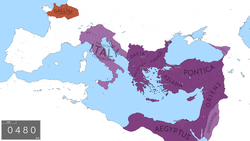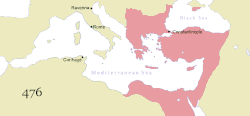Byzantine Empire
| |||||||||
|---|---|---|---|---|---|---|---|---|---|
| 457–518 | |||||||||
 The territory of the Eastern Roman Empire under the Leonid dynasty in 480. The Western Roman Empire, depicted in pink, collapsed in 476/480, though the regions depicted nominally continued to be under Roman rule as vassals of the Eastern Empire. | |||||||||
| Capital | Constantinople | ||||||||
| Common languages | Latin, Greek | ||||||||
| Government | Monarchy | ||||||||
| Emperor | |||||||||
• 457–474 | Leo I | ||||||||
• 474–474 | Leo II | ||||||||
• 474–491 | Zeno | ||||||||
• 475–476 | Basiliscus | ||||||||
• 491–518 | Anastasius I | ||||||||
| History | |||||||||
• accession of Leo I the Thracian | 7 February 457 | ||||||||
• death of Anastasius I Dicorus | 9 July 518 | ||||||||
| |||||||||
| History of the Byzantine Empire |
|---|
 |
| Preceding |
| Early period (330–717) |
| Middle period (717–1204) |
| Late period (1204–1453) |
| Timeline |
| By topic |
|
|
The Eastern Roman Empire was ruled by the House of Leo from AD 457, the accession of Leo I, to 518, the death of Anastasius I. The rule of the Leonid dynasty coincided with the rapid decline, collapse and eventual fall of the Western Roman Empire. Following the end of the Western Empire, Emperor Zeno abolished the position of Western Roman Emperor and declared himself the sole Roman Emperor. The Eastern Roman Empire would come to last for several more centuries, and subsequent dynasties would invest large amounts of resources in attempts to retake the western provinces.
The Leonid dynasty also ruled the Western Roman Empire from 474 to its abolishment in AD 480.
